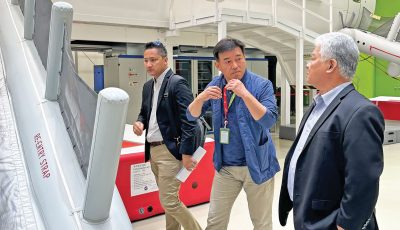Pinyin!
An alert Saipan Tribune reader brought this news item to my attention: Zhou Youguang, the developer of the Pinyin system of Chinese, passed away on Jan. 14. He was 111 years old.
I’m going to take a broad look at Pinyin. Then I’ll mention why it matters on Saipan.
Even if you’ve never heard the term “Pinyin,” you’ve heard Pinyin terms. For example: “Beijing.” That’s the capital of China. It’s also a Pinyin word, a word that puts a Chinese term into our alphabet so we can pronounce it.
Seems simple, right? It’s not. Romanizing the Chinese language has proven to be as elusive as curing the common cold. Various remedies continue to compete for attention. Pinyin was established in mainland China in the 1950s, and it is the dominant method now, but in the big, wide world you can certainly encounter other methods.
Speaking of the big world, you’ve heard of Peking, right? It’s one of the world’s most famous cities. Here’s a great bet for happy hour tonight: How far is Peking from Beijing?
Well, we can say that they’re easily within walking distance of each other. That’s because Peking and Beijing are the same city. So this isn’t an issue of geography; it’s an issue of linguistics. It’s the same city, the same word, and the same written characters in Chinese. The only difference is that “Peking” is an old way of trying to convey the pronunciation alphabetically, and, now, in the Pinyin era, “Beijing” is the conventional way to spell it out.
Even after Pinyin became dominant, some of the legacy terms, such as “Peking,” were so widely written into the world’s habits that they stuck around.
Since Pinyin puts things in alphabetical terms, it makes it easy to use an alphabetized English/Chinese dictionary. If you steer toward your average bookstore, at least in the English-speaking world, you’ll find that Pinyin is a basis for most such dictionaries.
It also makes for a common way to use computer keyboards. When using a Chinese word-processor, the Pinyin can be typed, and then a list of corresponding Chinese characters will pop up. The user then picks the intended character, moves on to the next word, enters the Pinyin, and the process starts all over again.
Me, I’m up to 10 typos per minute using this method. I aim to improve, though, and I’ll be at 15 t.p.m. by the end of the year. Ah, progress. And you thought I had no aptitude for the language.
When I enrolled in Mandarin classes I found that the first topic in the first semester was Pinyin. This leads to an important point: Pinyin itself requires a bit of study. Although it uses our alphabet, some of its conventions for pronunciation are different than ours.
I found that abstract, textbook explanations helped a little, but not much. The best way to get a real handle on it was to plow through examples in usage, to note how each case worked, and then to compile a list of the rules that jibed the textbook rules with field experience. The whole list fits on one page, though I usually use a big font and let it bloat to two.
I’ve come to have a real appreciation for Pinyin since it has proven to be such a useful tool. But, again, as I’ve noted, there are other romanization methods, so there are dictionaries and word processors that use non-Pinyin alphabetical entries; these are, however, outside of my experience.
As for Saipan, many businesses that serve Chinese tourists have run, head first, into the hard fact that training sales staff to say a few basic phrases in Chinese is often a lot harder than training the staff to say a few basic phrases in Korean or in Japanese. Here and elsewhere, I’ve been on the management side of things where some sort of program had to be established for this stuff.
As for the Chinese phrases, the best solution I’ve come up with is to forget about getting a uniform level of training across the staff. It’s not going to happen, or, at least, I’ve never seen it happen. It’s better to instead find a few motivated workers who want to dig into studying the language. This is called leadership. Then throw some money at it. This is called investment.
With luck, your standouts can eventually become peer-leaders who can serve up some intelligible Chinese, which beats the likely alternative of having zero capabilities across the board. In the former case, Pinyin will probably be part of the learning gig, or maybe even the bedrock.
Pinyin has come to be the invisible bridge of Pacific communications. It carries a lot of traffic but it is seldom admired. So today is the day to offer some admiration, and well as appreciation and acknowledgment of its developer, Zhou Youguang.



























